Coral reefs, a testament to nature’s complexity and biodiversity, are composed of thousands of unique species, among which corals play a pivotal role. There are 3 types to categorize corals broadly: SPS corals, LPS corals, and Soft corals. Needless to say that they have their similarities and dissimilarities. Learning about their differences is imperative to be a successful reef hobbyist because each is particular with its maintenance.
Among the three, Soft corals or softies have no bony structure. They require the simplest upkeep. On the contrary, the other two have solid skeletons, Large Polyp Stony or LPS corals being more demanding than Softies but less demanding than SPS or Small Polyp Stony corals. The other differences vary within their tank requirements for survival and growth.
Research published in the journal Coral Reefs highlighted the importance of this trio in maintaining the health and balance of coral reef ecosystems, emphasizing their contribution towards nutrient cycling and habitat provision. This article dissects the remarkable differences between these coral types, enriching our understanding of these extraordinary organisms.
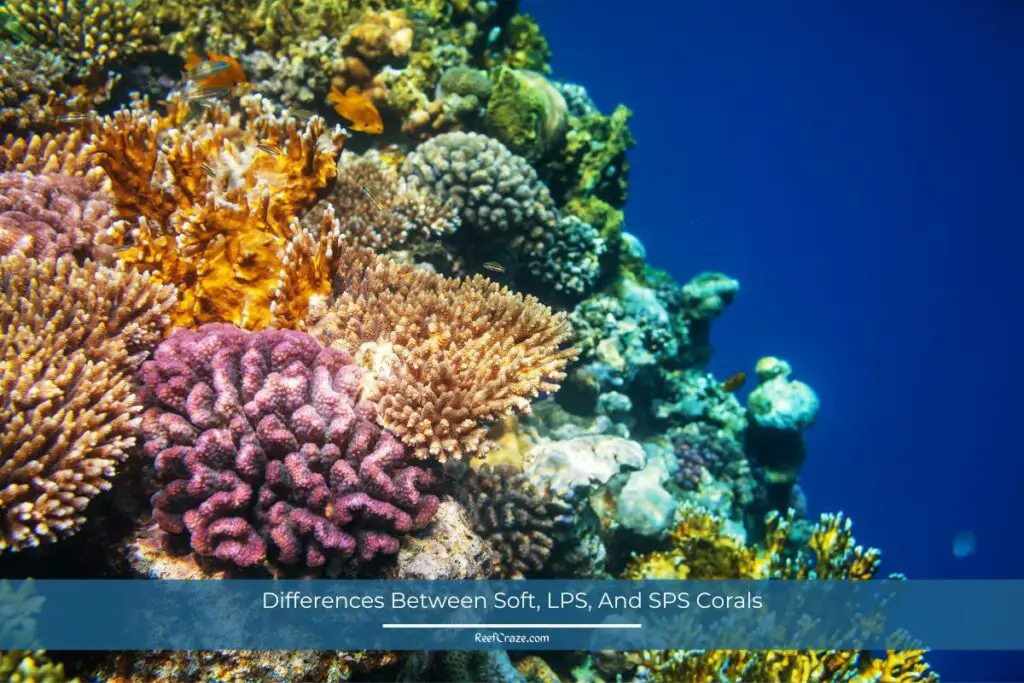
What are Soft, LPS, and SPS Corals?
At the heart of our journey, we have corals that are categorized into Soft, LPS (Large Polyp Stony), and SPS (Small Polyp Stony) varieties, each with distinctive attributes and behaviors that set them apart in the underwater world.
Soft Corals
Soft corals, often called “octocorals,” are marine organisms named after their fleshy, soft bodies. These creatures have an eight-fold symmetry, contrasting the typical six-fold symmetry of other corals. Without the rigid, calcified skeleton, soft corals rely on tiny, hard structures called “sclerites” that offer some degree of support and give these corals their characteristic flexibility.
LPS (Large Polyp Stony) Corals
As we delve deeper, we come across Large Polyp Stony corals, known in short as LPS corals. Characterized by large, fleshy polyps, these corals have a hard, stony skeleton made from calcium carbonate. These are the builders of the coral reefs and they come in an array of dazzling shapes and sizes. From the vibrant Torch Coral to the hypnotically swaying elegance of the Bubble Coral, each variety of LPS coral holds a unique charm.
SPS (Small Polyp Stony) Corals
Just as intriguing are the Small Polyp Stony corals, known as SPS corals. They too possess a hard, stony skeleton, yet what sets them apart is the multitude of small polyps that cover their surface. SPS corals, like the renowned Staghorn Coral, can form vast, branching structures and contribute significantly to the reef’s structural complexity, which in turn promotes a biodiverse marine environment.
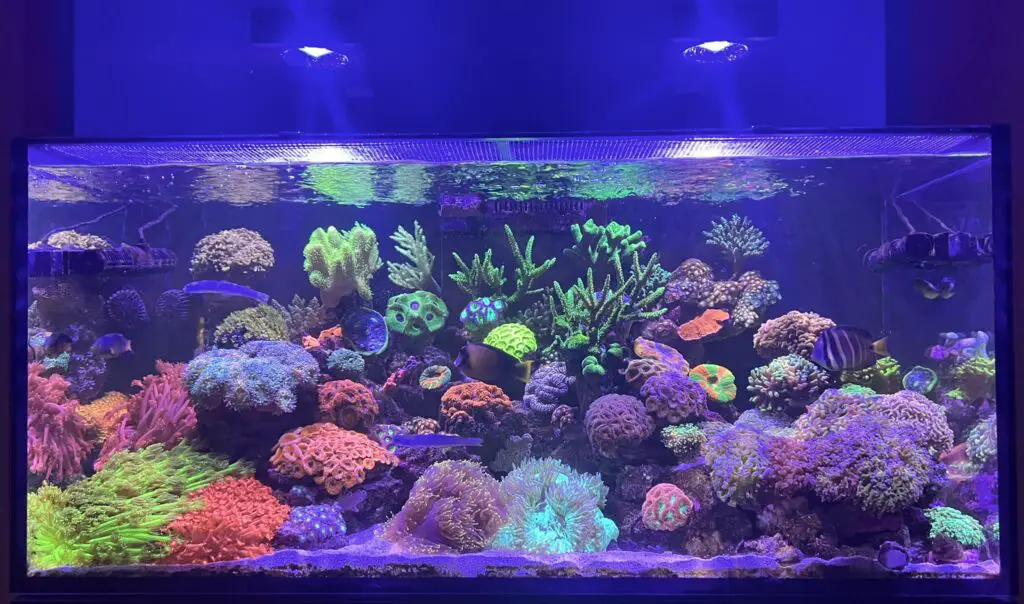
Differences Between Soft, LPS, And SPS Corals
Corals are invertebrates generally forming their population as colonies of polyps. However, some also live independently.
Corals possess unique biological characteristics that support organic food and photosynthesis equally, distinct from fishes and plants.
Each With Its Own Diet
Most corals produce their food partially by maintaining a symbiotic relationship with Zooxanthellae. They need light to conduct photosynthesis. When they prepare the food, they share it with corals in exchange for safe refuge.
But some corals need more than photosynthesis. They look for supplementary diets by hunting microorganisms. That is where the challenge lies for hobbyists. They must be attentive and put effort into making a diet with all the nutrition for their corals.
Polyps
Polyps are the one physical trait shared by all corals. Each coral is a colony of genetically identical polyps.
They have countless individual species to keep in your reef tank. While each has its uniqueness, you can classify them into 3 types. Now have a look at their profiles elaborately discussed below.
1. Soft Corals Or Softies
Resembling trees and plants, Soft corals are bendable, soft, and delicate, as their name tells you. That means they lack solid exoskeletons like the other types.
It is not that they do not have skeletons at all. They do. The name of their skeletal structure is sclerites, but it is not rigid and makes them supple.
The colonies of Softies are typically lobate, encrusting, fan-shaped, arborescent, digitate, and membranous. Some are also bushy, massive, or whip-like.
Physical Structure
Structurally, the tissues of Soft corals’ polyps form a sheet-like connection called coenosarc. Some softies encrust their bodies with sea objects, while others apply a fibrous protein to make a tree-shaped look.
Diet
Zooxanthellae assists Softies in partly fulfilling their dietary needs. Along with that, they also fetch ciliates and plankton from the sea’s water columns.
As far as your reef tank has a healthy environment decorated with live rocks, the microorganisms should be there naturally. With the help of sufficient lighting, they will handle the food requirements for your Softies. As for supplement food, you can purchase different coral foods to feed them occasionally.
Toxins
In the wild, Soft corals live with different aggressive predators. So they need to develop a defense mechanism to protect themselves. You must know about it if you want them in your tank because there will be other creatures too.
They cannot use force using any structural power, so they release chemical toxins to fight against their predators. Whenever anything dangerous gets too close to them, they inject them with that toxin using their stingers.
Some chemicals are not that severe for humans, but others are. The reaction will vary dramatically from one to another, more if it is allergic. So you should be cautious and wear protective gear when moving or placing your Soft corals.
So, there are two things to remember about adding Soft corals to your reef tank. First, keep them with those corals capable of defending themselves while maintaining a distance between them. Second, follow the same rule with fish too.
Propagation
Softies can reproduce asexually and sexually. Their colonies discharge eggs and sperm to the water column to fertilize the eggs and create a larva. One colony can form larvae in hundreds and thousands, which usually cannot survive in captivity.
Instead, a more viable reproduction option is budding with dividing, where each polyp gets split into two horizontally or vertically.
Lighting And Water Flow
They have the fewest demands in terms of lighting and water flow criteria. When you set up your home tank, arrange low- to mid-intensity lighting. The same goes for water flow. This low-cost arrangement will be enough to keep your Softies satisfied. That makes them the most suitable corals for beginners in every way – budget, expertise level, effort, and whatnot.
Popular Soft Corals
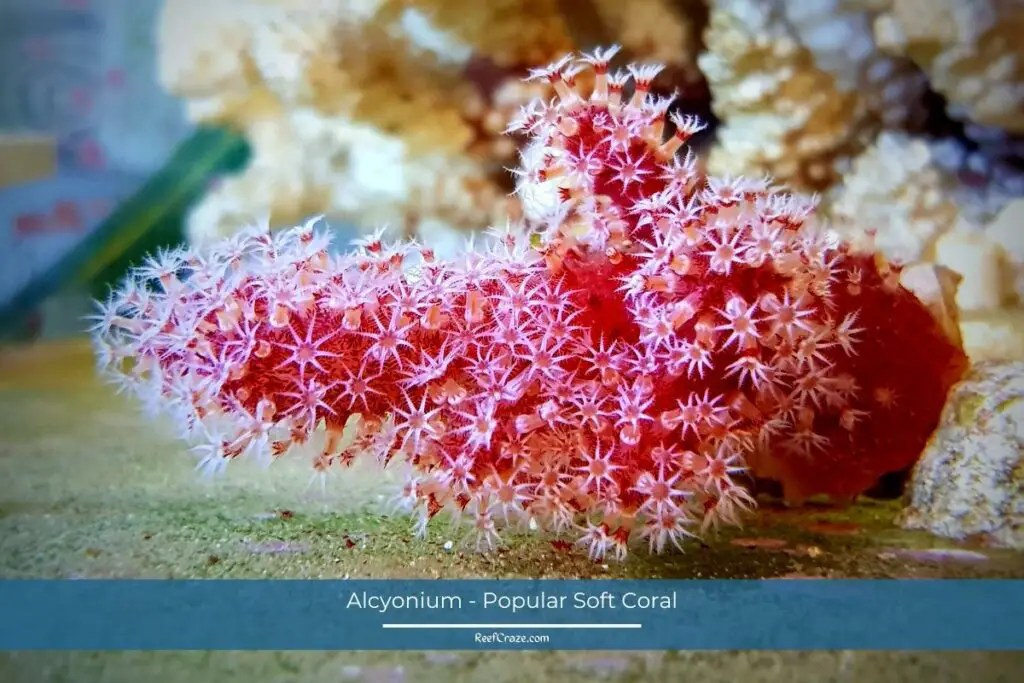
Alcyonium, Palythoa, Discosoma, Zoanthus, and Pachyclavularia are the most popular corals among reefers. Research them first when contemplating keeping them. They will surely add value to your reefing experience while adding beauty and life to your reef tank.
2. Large Polyp Stony Or LPS Corals
LPS corals are a bit high-maintenance compared to Softies but are more accommodating than SPS corals. Therefore, most beginners proceed with them after gaining some experience with Soft corals.
These corals have bigger and fleshier polyps than SPS. That is another reason why many reefers prefer them – their wholesome appearance. You will find them everywhere and purchase them at an affordable price. Furthermore, their forgiving nature of water quality fluctuations will help you learn more about reefing and be a better reefer. Have a look at their key characteristics now.
Diet
LPS corals manage well enough with photosynthesis. But they like phytoplankton, zooplankton, shrimp, and copepods. You will find formulated LPS pellets in the market to feed them. Ideally, you should give them treats twice to thrice a week.
Tentacles
A defining physical characteristic of LPS corals is their sweeper tentacles. They use them to attack corals and fishes close to them. So, their position in a tank should be careful to prevent that occurrence.
You should also maintain the trace elements in your tank water. They are vital for the physical development of LPS corals. Besides, you must observe the pH and calcium levels. Drastic fluctuations of these elements can be harmful to their bony structure.
Lighting And Water Flow
LPS corals do great with mild to medium water flow and lighting because they live in deep waters in the wild.
Propagation
Beginners or hobbyists will love LPS corals because they can propagate them easily. If you can cut the polyps cleanly and attach the pieces or frags to the live rock in your tank, they will create an entirely new colony.
However, that is given that you know well enough about fragging. Otherwise, do not attempt it because your inexperience can instantly cause irreparable damage and even kill LPS corals.
Forgiving Nature
While they will not give you guilt trips for messing with the water conditions like their SPS fellows, they still require you to maintain them strictly. But yes, you will get time to resolve the issues before it is too late.
Popular LPS Corals
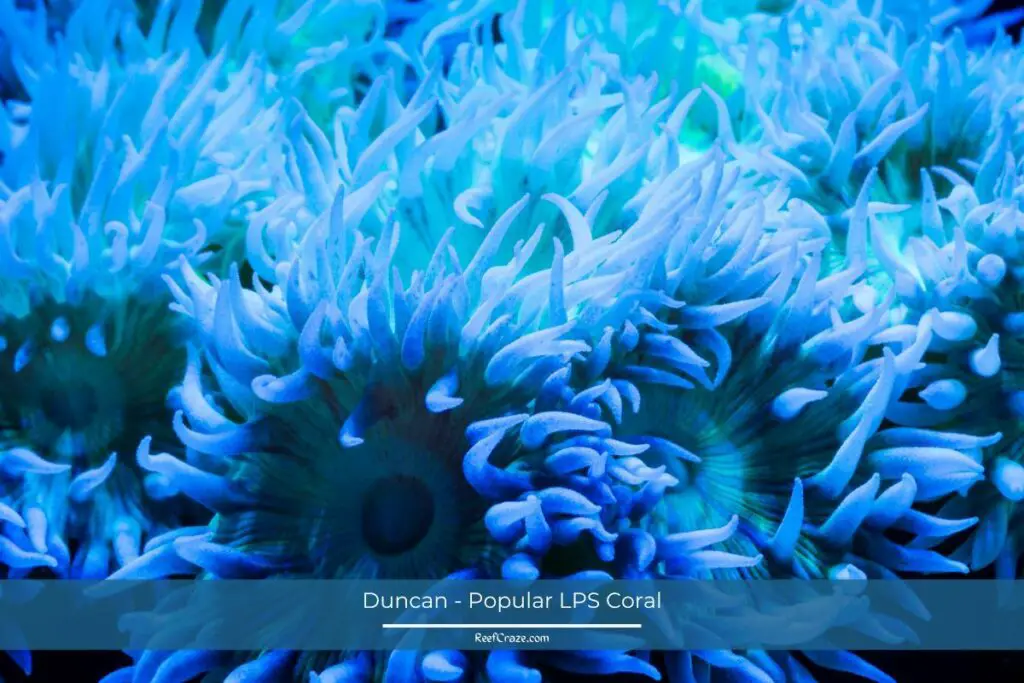
Some LPS corals adored by all reef keepers are Brain, Acan, Duncan, Euphylia, Chalice, and Plate corals. They are also some of the most beginner-friendly ones.
3. Small Polyp Stony Or SPS Corals
SPS corals are what people probably visualize in their minds when thinking of corals. As much as one would be tempted to have them, they should also be warned about the difficulty of looking after them in home tanks.
Usually, you will face either of the following consequences: your SPS corals will thrive, giving you a satisfying reefing experience, or they will shrink and die, making you feel hapless.
Too Demanding
First things first – too demanding does not mean that SPS corals demand a lot of things. Their requirements are similar to other corals. The only difference is that they need you to abide by them strictly. They will not tolerate any changes in the parameters. That is why you need to have experience in reefing before having them in your tank.
Lighting
SPS corals want powerful lighting, but there is more. They are very picky about their environment. So you will need to have them acclimatize to your tank’s lighting after getting them.
First, keep them somewhere with low lighting before moving them into the tank and finding the perfect spot. It is a tricky job as you should be prepared to place them immediately at the initial symptom of distress. One way to indicate their stress is shrunk polyps. When they extend fully, it means they are healthy.
Water Flow
Since their natural habitat is beneath shallow waters, SPS corals prefer medium to high water flow in captivity to help them with photosynthesis and waste disposal.
Moreover, the high flow is necessary to fetch micro foods from the water column while contributing to respiratory issues. It is something you cannot compromise because they are extremely sensitive and dependent on proper water flow, so much so that the lack of sufficient flow will cause them to lose their flesh and then their life.
Diet
They share similar diets with LPS corals. Apart from photosynthesis, they receive zooplankton and find tiny food particles in the water column.
Propagation
Most SPS corals populate fast on their own in an ideal tank environment. They sometimes shade out their tank mates, too. Be careful about that. Besides, you can propagate them like LPS corals.
Popular SPS Corals
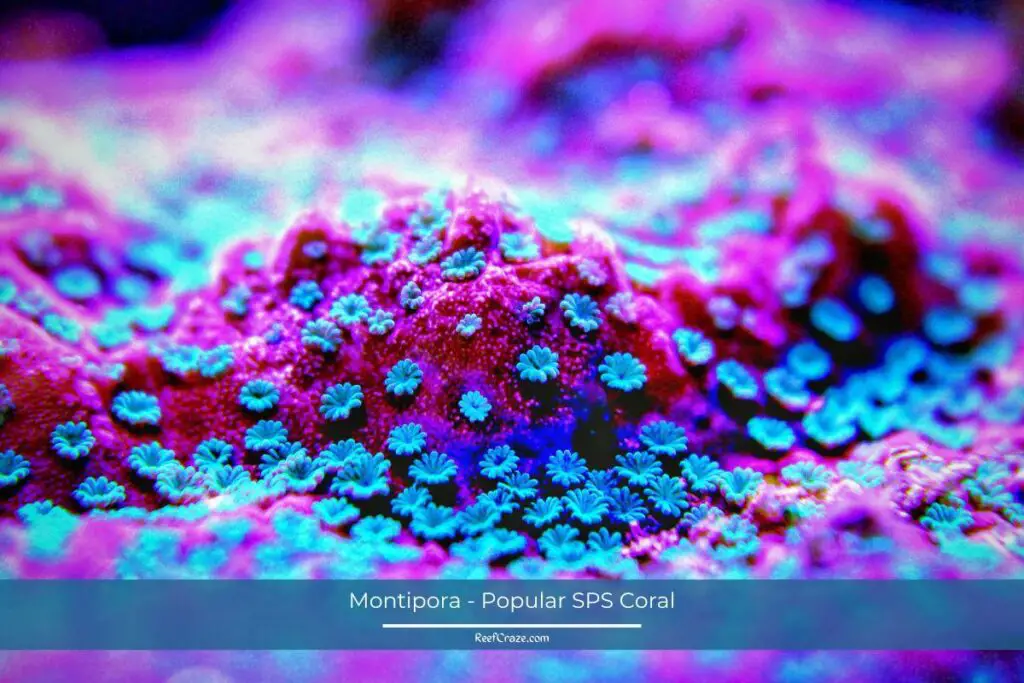
Even if you are skilled at keeping Soft and LPS corals, it will bode well for you to begin with easygoing SPS corals. For example, Montipora, Bird’s Nest, Boulder, Leaf, Porites, and Stylophora are amazing options for beginners and hobbyists with intermediate skills.
Frequently Asked Questions
How do Soft, LPS, and SPS Corals Differ in Their Physical Structure?
Soft, LPS, and SPS corals each display unique physical structures within the coral reef ecosystem.
Soft corals have a flexible, tree-like structure and possess eight feathery tentacles per polyp, lacking both a rigid skeleton and a central mouth.
In contrast, LPS corals have a stony skeleton covered by a thin tissue layer, boasting large, vibrant polyps that add to their visual appeal.
SPS corals, meanwhile, exhibit smaller, less prominent polyps, yet build large, branching structures with a highly calcified, stony skeleton, making them more rigid and less flexible than their soft and LPS counterparts.
How does Polyp Size Influence the Behavior of Soft, LPS, and SPS Corals?
The size of the polyp significantly impacts the behavior of soft, LPS, and SPS corals, affecting their feeding, growth, and defense strategies.
Soft corals have smaller polyps and favor passive feeding, relying on extracting nutrients from the water and their symbiotic relationship with photosynthetic algae, zooxanthellae.
LPS corals have larger polyps and are aggressive feeders, capturing plankton and small fish, but they also rely on their zooxanthellae.
SPS corals, with small polyps, mainly depend on nutrients provided by their zooxanthellae and are known for their fast growth rates and competitive behavior.
What are the Distinct Environmental Preferences of Soft, LPS, and SPS Corals?
Each type of coral also has distinct environmental preferences.
Soft corals are tolerant of various conditions and can thrive in habitats ranging from shallow seagrass beds to deep-sea cliffs. They prefer areas with moderate to strong water currents and can handle lower light levels.
LPS corals typically inhabit calmer, nutrient-rich waters with lower light and water flow.
SPS corals prefer high-energy environments in shallow, clear waters with high sunlight penetration and strong water currents.
These preferences showcase the remarkable adaptability of corals to colonize diverse marine environments.
How do Soft, LPS, and SPS Corals Differ in their Growth Rates and Patterns?
The growth rates and patterns of soft, LPS, and SPS corals are influenced by their environmental conditions and survival strategies.
Soft corals grow rapidly and have a tree-like pattern.
LPS corals grow slowly due to their energy-intensive calcification process and have varied growth patterns.
SPS corals can grow rapidly under optimal conditions and often form large, branching structures.
How do Soft, LPS, and SPS Corals Contribute to Reef Building?
All coral types contribute to reef building in their unique ways.
Soft corals do not directly contribute to reef building due to their lack of hard skeletons, but they provide habitat for marine species, contribute to nutrient cycling, and compete with algae for space.
LPS corals, with their hard skeletons, contribute significantly to the reef structure.
SPS corals, due to their fast growth rates and branching structures, are considered the primary architects of reefs.
How do Soft, LPS, and SPS Corals Respond to Environmental Threats?
Corals respond differently to environmental threats.
Soft corals, due to their flexibility and rapid growth rate, are more resilient to physical disturbances but are susceptible to bleaching.
LPS corals are more resistant to diseases and parasites, but they are vulnerable to bleaching and can be significantly affected by temperature extremes and poor water quality.
SPS corals are particularly susceptible to physical damage and bleaching, but they can recover quickly if conditions improve.
These responses highlight the fragility of corals and the need for conservation strategies to protect these vital ecosystems.
Can I Keep SPS Corals With LPS Corals?
I would not recommend it, but you can keep SPS and LPS together. The placement is important here. You must put your SPS corals in the upper areas with higher water flow and lighting. But the LPS corals should be at a lower place with dimmer light and gentler water flow.
Additionally, SPS corals cannot defend themselves against aggression. And their stringent tank requirements are another reason to keep them apart from one another. So most reefers have their tanks for SPS only. It lets you concentrate on specific species at a time, which benefits you and them both.
Can I Keep LPS Corals With Softies?
Yes, as far as you keep them sufficiently distant and safe from each other’s toxins or tentacles, they will be okay.
Can I Keep Stony Corals With Soft Corals?
Technically, yes. You can keep all three corals in the same tank. It is usually known as a mixed reef. However, taking care of them with their varying requirements will be tremendously challenging. It is an absolute no for beginners and hobbyists.
Even if you are an expert, taking on this challenge will not be a recommendation. That is because if you do succeed in keeping the environment alright for all of them, there is no guarantee they will not attack each other and cause a massacre inside your tank. It is best to keep the same coral species together.
Final Words
You cannot learn to keep corals successfully overnight. It will take weeks to even years to be an expert. But it should not stop you from building your own reef system.
Learn about corals as much as you can and start with the easiest ones based on your capability to invest your time and effort. Then work on your reef tank. Promote yourself from easy-to-maintain to challenging coral-keeping as you progress.
It may take time to be successful, but it will not take time to reward you with the most pleasing sights of your growing corals.
